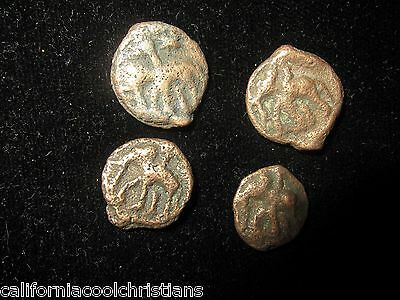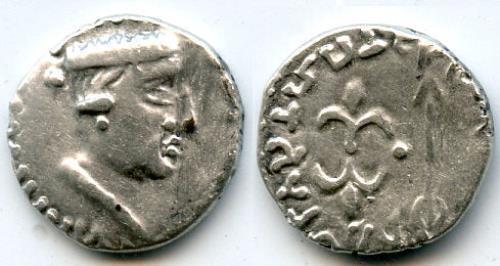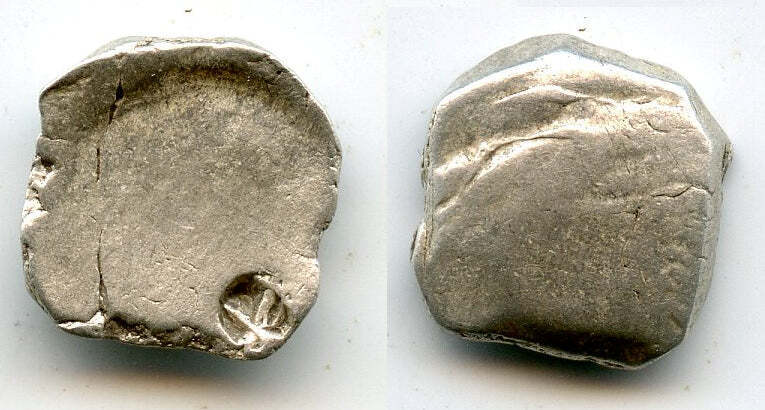-40%
1- VERY ANCIENT India SUNGA KINGDOM Coins 187 BC-100 AD Hindu / Buddhist
$ 20.05
- Description
- Size Guide
Description
ccr-ccc4uSUNGA KINGDOM COPPER COINS
This is for 1 - Beautiful
Very Ancient Coins 187-75 BC
1 - ELEPHANT WITH RIDER LEFT, THREE-ARCHED HILL WITH CRESCENT
'ROUND'
W: 2.6G / D: 13MM
187-75B.C.
I would grade these coins about Medium grade.
See photo for details
The
Sunga Empire
(or
Shunga Empire
) is a
Magadha
dynasty that controlled North-central and Eastern
India
as well as parts of the northwest (now
Pakistan
) from around 185 to 73
B.C.E.
It was established after the fall of the Indian
Mauryan empire
. The capital of the Sungas was Pataliputra. Later kings such as Bhagabhadra also held court at Vidisa, modern Besnagar in Eastern Malwa. The Sunga Empire is noted for its numerous wars with both foreign and indigenous powers although several kings patronized Buddhism. The Mathura school of art and the works of
Patanjali
colored North India during this empire. It was replaced by the Kanva dynasty.
The beginning of larger, centralized polities in India was largely in response to
Alexander the Great
's invasion of 326. Following the Mauryan Empire, the task of protecting India from invasion and of securing stable governance fell to the Sunga dynasty for the next century.
War
is said to have characterized this period although the Sungas also engaged in diplomacy. Significant religious developments took place. Patanjali's synthesis of the tradition of Yoga became the foundation of one of the Hindu "darshans" (schools of thought) and continues to enrich the lives of people all over the world. The
Bhagavad Gita
composed around about 150-100
B.C.E.
is one of the most popular of all Hindu scriptures. Buddhists would later move out of India, as rulers began to identify more closely with
Hinduism
but early Sunga support may have enabled Buddhism to thrive long enough for the monks to complete their journey to more receptive areas. The Sunga Empire played an important role in patronizing Indian culture at a time when some of the most important developments in Hindu thought were taking place. The richness of India's spiritual tradition, from which the whole world has gained insight, owes much to this period.
The last ruler of the Mauryan dynasty was Brithadratha. He was killed by his own commander-in-chief
Pushyamitra Sunga in 185 BC.
With the fall of Mauryas, India lost its political unity. Pushyamitra Sunga became the ruler of the
Magadha and neighboring territories. The north-western regions comprising Rajputana, Malwa and
Punjab passed into the hands of the foreign rulers. The kingdom of Pushyamitra was extended up to
Narmada in the south, and controlled Jalandhar and Sialkot in the Punjab in the north-western regions.
Pushyamitra died after ruling for 36 years (187-151 BC). He was succeeded by his son Agnimitra.
Agnimitra used to hold his court in the city of Vidisa, modern Besnagar in Eastern Malwa. The power of
the Sungas gradually weakened. It is said that there were ten Sunga kings
.
The most important aspect of cast copper coins is that they do not contain any signs of any king or
dynasty.
Thus their designs hardly indicated any change.
Among the common symbols used in cast
copper coins are animal and folk or religious symbols.
The animals represented in the symbols are
elephant, horse, camel, bullhead and snake (or river).
Religious symbols include a three-arched figure
with crescent (chaitya
), cross, 'tree in railing' (or Bodhi-druma
),
swastika, a ladder, and a triangleheaded
standard (Indraddhaja
or Maitraka
).
The coins were prepared by pouring molten metal into a
shallow mold made of burnt clay.
DISCOUNT ON SHIPPING FOR MULTIPLE PURCHASES
FASTEST SHIPPER ON EBAY
ALL MY ITEMS ARE SHIPPED THE DAY OF PURCHASE IF PAID BEFORE 1:00PM.
ALL ITEMS PAID AFTER 1:00PM WILL BE SHIPPED THE NEXT DAY…
*** GUARANTEED ***
***Please don’t hold me responsible for the Post office shipping time when leaving feedback***
Thank You for your Purchase and Please come back soon
All orders come with a 5% discount card good for your next purchase
Not Responsible for any further charges including Customs.
If unsure about Customs charges contact the Customs Office in your Country
All coin orders over .99 gets a
FREE Ancient Roman Coin
in a Display Album with the Story of the coin and a
"Certificate of Authenticity"
Froo www.froo.com | Froo Cross Sell, Free Cross Sell, Cross promote, eBay Marketing, eBay listing Apps, eBay Apps, eBay Application










